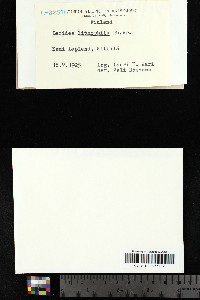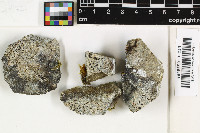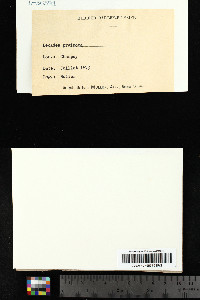
Consortium of Lichen Herbaria
- building a Global Consortium of Bryophytes and Lichens as keystones of cryptobiotic communities -
- Home
- Search
- Images
- Species Checklists
- US States: O-Z >
- US National Parks
- Central America
- South America
- US National Parks
- Southern Subpolar Region
|
|
|
|
Family: Lecideaceae
[Lecidea daphaena var. ochracea Ach., moreLecidea lapicida var. lithophila Ach., Lecidea lithophila f. ochracea (Ach.) Nyl., Lecidea lithophiliza Nyl., Lecidella lithophila (Ach.) Arnold] |
Ecology: Biotroph; lichenized; endosubstratic or episubstratic; i.e., bricks; substrate non-calciferous or metalliferous. Thallus: Not subdivided parts, areolate (primarily areolate), continuous throughout; lobes angular at the front; separate thallus parts 0-1 mm thick. Thallus Size and Differentiation: Large; main branches basally not constricted. Thallus Outline: Margin concolorous the thallus centre. Upper Surface: White, lemon (citrine), brownish yellow, grey, brown (pale beige), or red (rusty coloured by Fe), plane; not sorediate; without thalloconidia thalloconidia. Medulla: Iodine reaction in Lugol's solution negative. Ascocarps: Forming on the pro- or hypothallus, soon sessile, not constricted, slightly constricted, or strongly constricted at the base, 20-200 per cm², .4-1-(2.7) mm in diam.. Margin: Not flexuose or slightly flexuose, persistent or excluded, 50-90 µm wide, epruinose or distinctly pruinose. Disk: Plane to weakly convex, black or brown, epruinose, pruina scarce or abundant, without an umbo. Exciple: Hyphae radiating outwards; 2-3.5 µm wide; grey or yellow (dissolving in KOH); inspersed with crystals (dissolving in KOH). Epithecium: Apical cells olive or brown, cell pigment reacting with 10% HCl (in H2O). Hymenium: 45-80 µm high; white; iodine reaction: Lugol’s positive. Subhymenium: 25-45 µm high; white. Hypothecium: White. Ascospores: Ellipsoid, (6)-9.1-14-(21) µm long, (3)-4.4-6.3-(8) µm wide; wall not ornamented. Conidia: (10)-(Schwab 1987) 10-13-(13) µm long. Secondary Metabolites: Present, 4-O-demethylplanaic acid and planaic acid. Spot Tests: Medulla: K –, C –, PD – ascocarp margin (in section): K –, C – disk: C – hypothecium: K – epihymenium: K –. |
Powered by Symbiota


























































